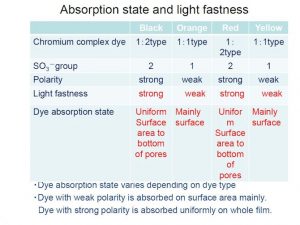AAC Annual Conference Presentation
 This year at the Aluminum Anodizing Council (AAC) annual conference Okuno was given the opportunity to present some new research that we have been conducting to further our and, by proximity, your understanding of aluminum anodizing. The presenter, Mr. Hara, has been with Okuno for 20 years. As a manager of the Anodizing department he oversees many of the R&D projects conducted by Okuno. The presentation that he gave at the AAC this year was titled “Dyeing and Light Fastness of Aluminum Anodizing”. It details the impregnation of organic dyes into the anodizing film, and the affect of sealing and film thickness on the light-fastness of the dyes.
This year at the Aluminum Anodizing Council (AAC) annual conference Okuno was given the opportunity to present some new research that we have been conducting to further our and, by proximity, your understanding of aluminum anodizing. The presenter, Mr. Hara, has been with Okuno for 20 years. As a manager of the Anodizing department he oversees many of the R&D projects conducted by Okuno. The presentation that he gave at the AAC this year was titled “Dyeing and Light Fastness of Aluminum Anodizing”. It details the impregnation of organic dyes into the anodizing film, and the affect of sealing and film thickness on the light-fastness of the dyes.
As many of you know we spend a lot of our resources on R&D. We do this to not only bring the best products to market but also help provide a better understanding of the processes we supply chemicals for. It is the latter that led us to investigate the topics presented here. We used our dyes, picking a Chromium complex Azo, Anthraquinone, Phtalocyanine, and Xanthene dye. We anodized a type II class 2 film and tested both sealed and non-sealed films. We also investigate the effect that some coatings can have on the dyed aluminum which is detailed in the original presentation.
Deeper Than You Think
The common thought on dye impregnation is that most organic dyes only absorb into about the top 30%-50% of the pore. Through analysis with GD-OES (Glow Discharge Optical Emission Spectroscopy) we found that certain dyes absorb deeper which depended on the polarity of the dye. The depth that the dye absorbed into the pore had a direct relationship to its light-fastness. 
A Good Seal
We found that a good seal plays a major role in the light-fastness of the dyes. Even the dyes that were able to absorb deep into the pore there was a vast difference between sealed and non-sealed films. This is due to molecules, specifically oxygen, and the environment that surrounds the dye. A good seal can protect the dye from the environments that are detrimental to its stability.
Conclusion
For some this has been a lot of information and for some of you this is mostly already known to you. The presentation is too big to put here and contains a lot of the finer points of the research that this post lacks. If you have questions or would like to obtain a copy of the presentation please contact your local Okuno Rep or through our contact us page.

